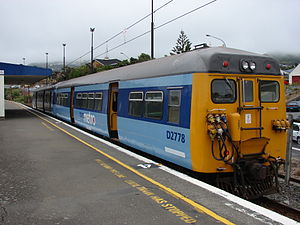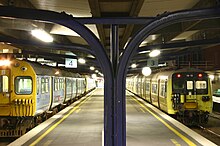
The Ferrymead Railway is a New Zealand heritage railway built upon the track formation of New Zealand's first public railway, from Ferrymead to Christchurch, which opened on 1 December 1863. On the opening of the line to Lyttelton on 9 December 1867, the Ferrymead Railway became the Ferrymead Branch and was closed shortly thereafter. In 1964, rail enthusiasts began relaying track on the historic formation and the new 3 ft 6 in narrow gauge. Ferrymead Railway officially reopened in 1977. It now operates steam, diesel and electric trains regularly and is recognised as one of the most significant rail preservation sites in New Zealand.
Tranz Metro was a New Zealand public transport operator. Beginning as the New Zealand Railways Corporation's Cityline division as a result of restructuring in the 1980s, in its final form Tranz Metro was the operator of Metlink's suburban trains owned by the Greater Wellington Regional Council in the Wellington Region of New Zealand.

Public transport in the Wellington Region, branded under the name Metlink, is the public transport system serving Wellington and its surrounding region. It is the most used public transport system in New Zealand per capita, and consists of electric and diesel buses, suburban trains, ferries and a funicular. It also included trams until 1964, and trolleybuses until 2017.

The DQ and QR class were a class of diesel locomotives in New Zealand and Tasmania, Australia. Originally built by Clyde Engineering in the 1960s as Queensland Rail 1460 and 1502 class locomotives, they were purchased by Tranz Rail in 1995 to be rebuilt, as a cheaper alternative to buying new locomotives.
This is a list of jargon commonly used by railfans and railway employees in New Zealand.

The New Zealand EW class locomotive was a type of electric locomotive used in Wellington, New Zealand. The classification "EW" was due to their being electric locomotives allocated to Wellington. For two decades until the advent of the DX class they were the most powerful locomotives in New Zealand.
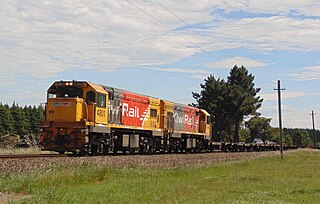
The New Zealand DC class locomotive is a type of diesel-electric mainline locomotive on the New Zealand rail network, operated by KiwiRail on freight trains, and formerly on long-distance passenger trains. The class was rebuilt from the DA class in the late 1970s and early 1980s, mainly in Australia. After the DA class, they were the most numerous class of diesel locomotive on New Zealand's railway network and remained numerically dominant until the mid-2010s when withdrawals began.

The New Zealand DE class was a class of fifteen diesel-electric shunting locomotives, introduced by the New Zealand Railways (NZR) with an intention to replace steam locomotives on shunting duties with diesel power. The class was physically similar to the Tasmanian Government Railways X class, which was also of English Electric design.
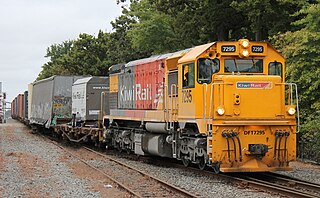
The New Zealand DF class locomotive of 1979 is a class of 30 Co-Co diesel-electric locomotives built by General Motors Diesel of Canada between 1979 and 1981. Between 1992 and 1997, all the locomotives were rebuilt as the DFT class, a turbocharged version of the DF.

The New Zealand EM/ET class electric multiple units were used on suburban services in Wellington, New Zealand from 1982 to 2016. They were owned initially by the New Zealand Railways Corporation and finally by the Greater Wellington Regional Council (GWRC) and operated by Tranz Metro, part of national railway operator KiwiRail.

The Wairarapa Connection is a New Zealand interurban commuter rail service along the Wairarapa Line between Masterton, the largest town in the Wairarapa, and Wellington. It is operated by Wellington suburban operator Transdev under contract from the Greater Wellington Regional Council. It is a diesel-hauled carriage service, introduced by the New Zealand Railways Department in 1964 after passenger demand between Masterton to Wellington exceeded the capacity of the diesel railcars then used.
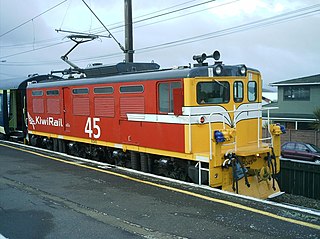
The New Zealand EA class of electric locomotives were used on the New Zealand rail network between 1968 and 1997 on the Otira – Arthur's Pass section of the Midland line in the South Island, through the Otira Tunnel. Following reconditioning, three were used by KiwiRail's Tranz Metro in Wellington from 2008 to 2011 to top and tail Metlink suburban passenger trains as an interim measure before new rolling stock arrived. Four of the five locomotives were scrapped in 2013 with one being set aside for preservation.

The Hutt Valley Line is the electrified train service operated by Transdev Wellington on behalf of Metlink on the section of the Wairarapa Line railway between Wellington and Upper Hutt, New Zealand.

The Johnsonville Branch, also known as the Johnsonville Line, is a commuter branch line railway from the main Railway Station of Wellington, New Zealand to the northern suburb of Johnsonville via Ngaio and Khandallah.
The Petone Workshops were a government-owned railways maintenance and repair facility located in Petone, in Lower Hutt in the Wellington region of New Zealand's North Island. It took over construction and maintenance of rolling stock in the Wellington region from the Pipitea Point facility, starting in 1876, and became the only such facility in the region from 1878 until the opening of the replacement Hutt Workshops facility in 1929.

The New Zealand FP/FT "Matangi" class is a class of electric multiple units used on the suburban rail network of New Zealand's capital city, Wellington. The class, consisting of an FP power car and an FT trailer car, operates services on all electrified lines of the network which comprise the Kapiti, Hutt Valley, Melling and Johnsonville lines. The units are owned by Greater Wellington Rail Ltd, a subsidiary of the Greater Wellington Regional Council (GWRC), and have been operated by Transdev Wellington under contract to the GWRC since 2016. They were previously operated by Tranz Metro, a former division of KiwiRail.

Manor Park railway station is a suburban railway station serving the suburb of Manor Park in Lower Hutt, New Zealand. The station is located on the Hutt Valley section of the Wairarapa Line, 23.7 km (14.7 mi) northeast of Wellington. The station is served by Metlink's electric multiple unit trains of the "Matangi" FP class. Trains stopping at Manor Park run to Wellington and Upper Hutt. The station has an island platform between two tracks.

The New Zealand British Rail Mark 2 carriages were built by British Rail Engineering Limited for British Rail in the early 1970s. From the mid-1990s, 150 were exported to New Zealand. After being rebuilt, refurbished and re-gauged, they entered service with a variety of operators on New Zealand's railway network. The carriages generally replaced older NZR 56-foot carriages, some of which had been in use for almost 70 years.

Naenae railway station is a suburban railway station serving Naenae and Avalon in Lower Hutt, New Zealand. The station is located on the Hutt Valley section of the Wairarapa Line, 18.3 km (11.4 mi) north of Wellington. The station is served by Metlink's electric multiple unit trains of the "Matangi" FP class. Trains stopping at Naenae run to Wellington, Taitā and Upper Hutt.

Transdev Wellington is the operator of Wellington's Metlink rail network in New Zealand. The entity is a partnership of Transdev Australasia and Hyundai Rotem, who were awarded the contract to operate and maintain the commuter rail system in December 2015 by the Greater Wellington Regional Council. The contract commenced on 3 July 2016, taking over from KiwiRail division Tranz Metro.
